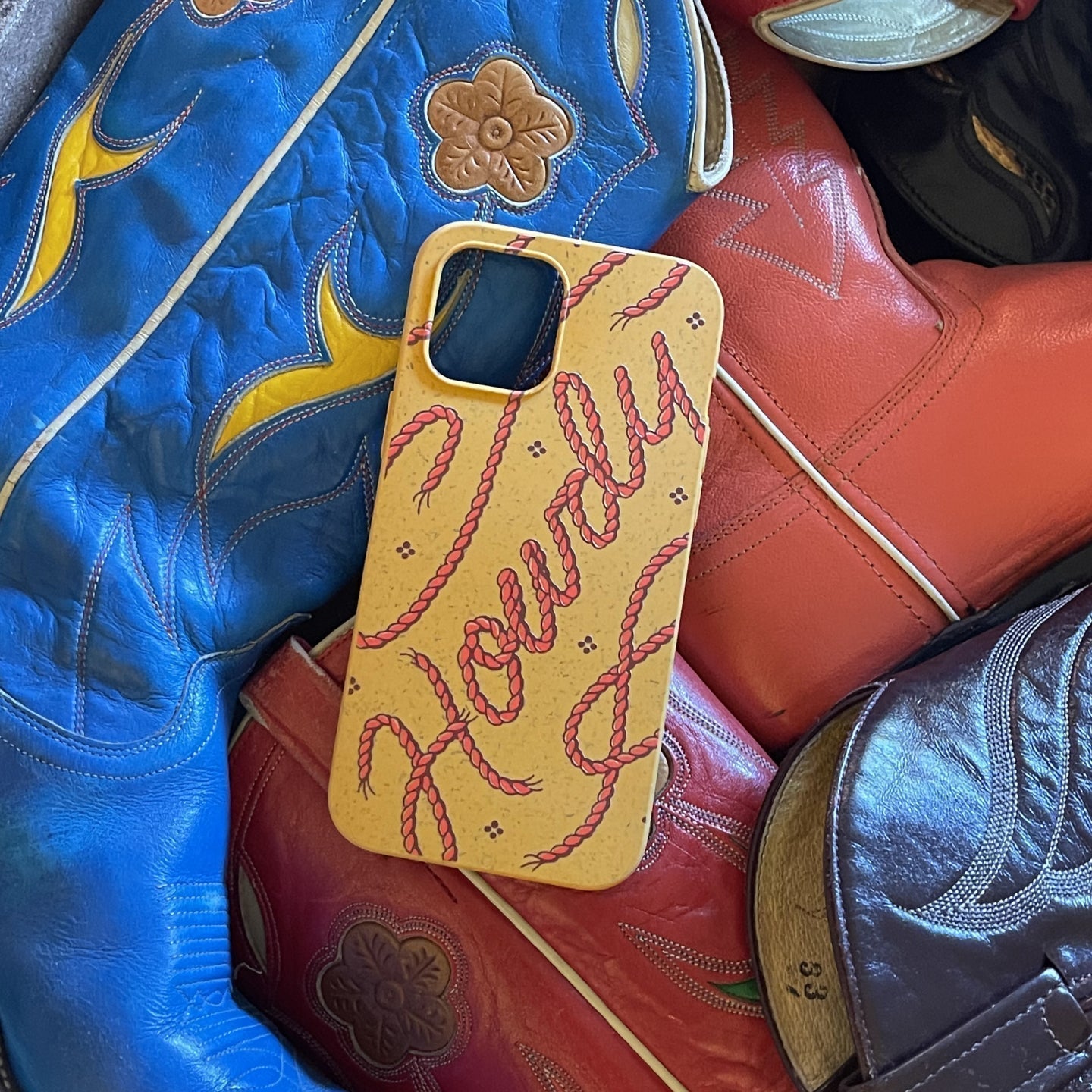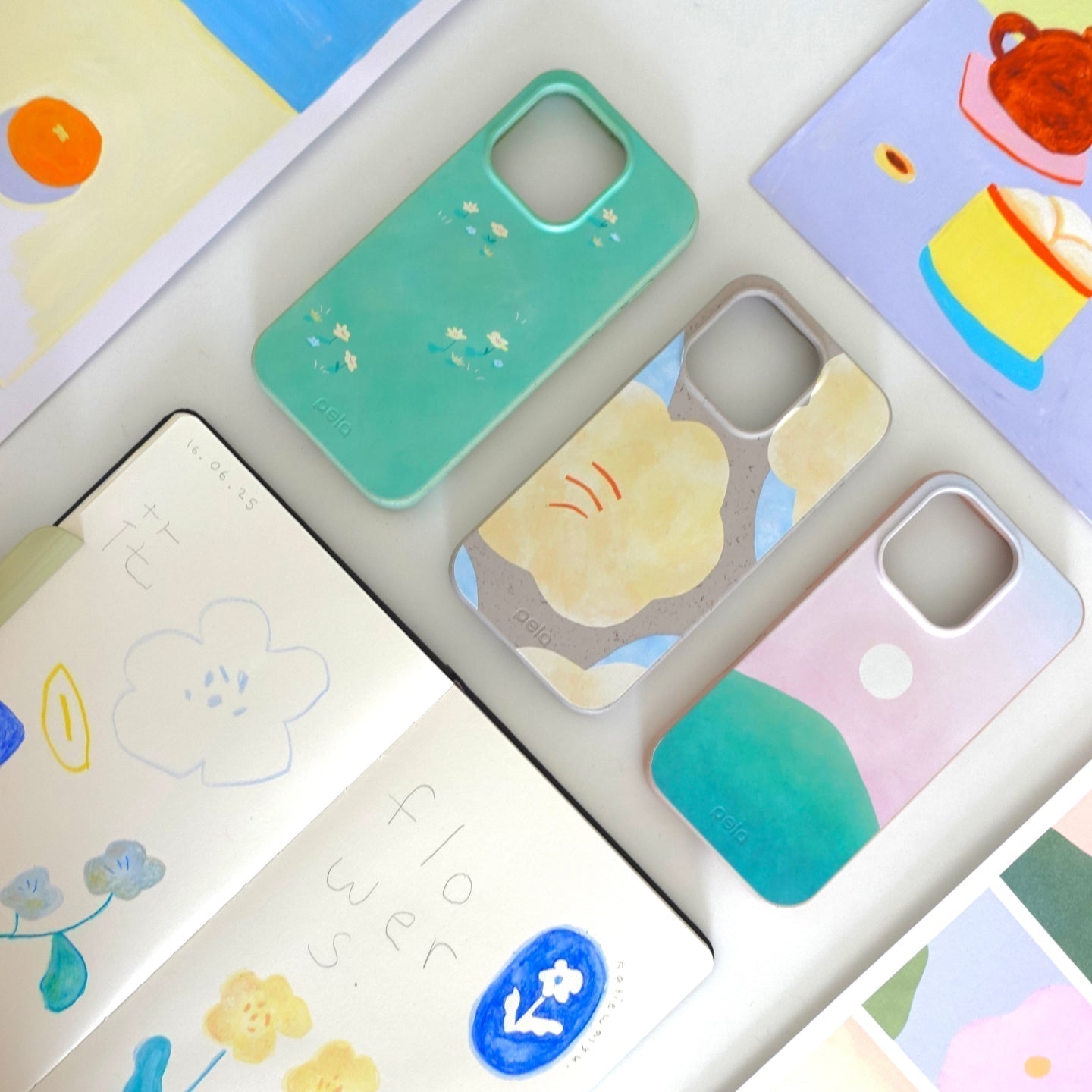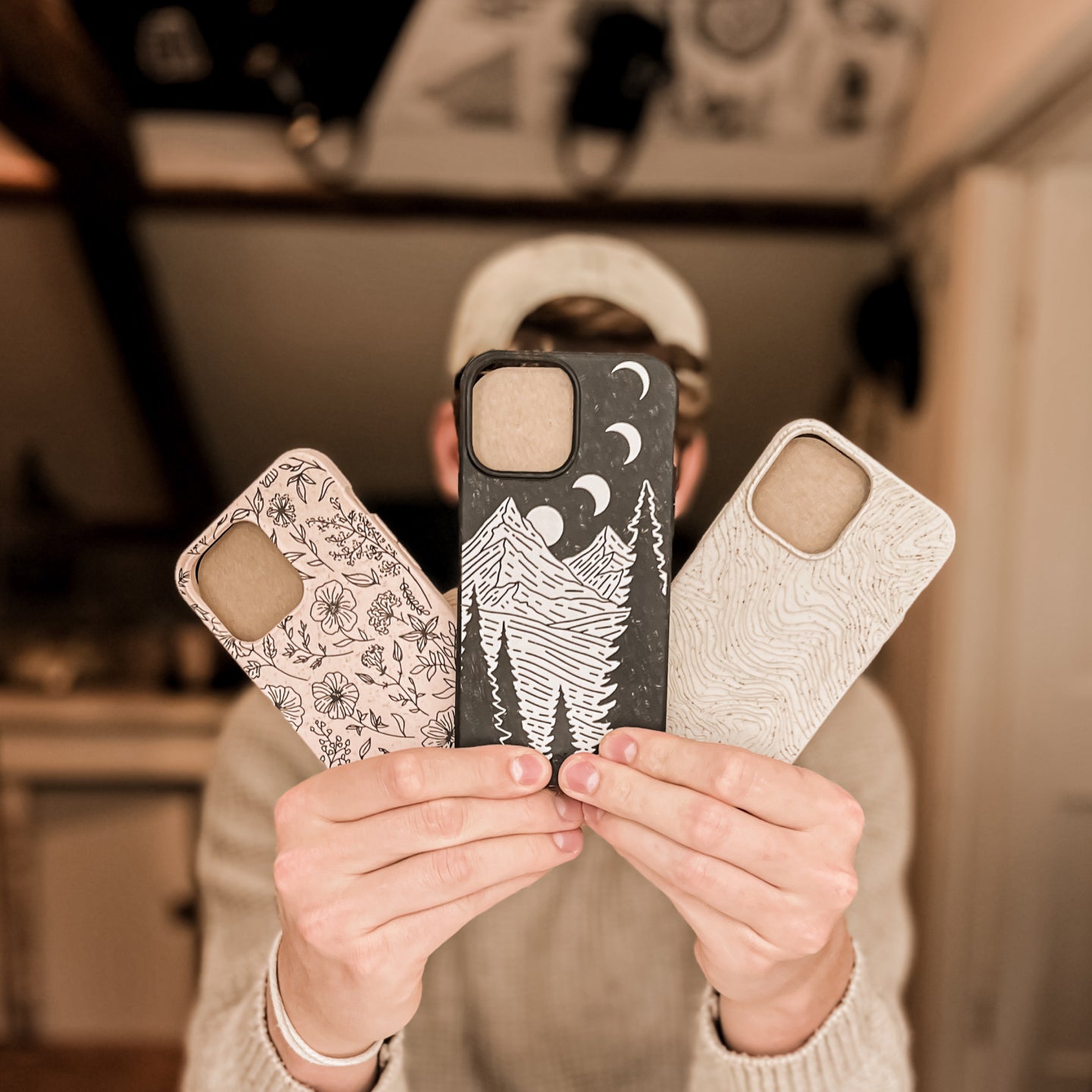
Pela is known for our compostable phone cases and other phone accessories like our AirPods cases and Apple Watch bands. However, one thing that is very important to us is that we even take significant initiatives to protect the earth.
Not only have we designed our products with a compostable plastic, but we take extra care to reduce our emissions and become Climate Neutral Certified. Pela Case will even take your old phone case off your hands and recycle or upcycle it for you.
Learn 5 Things Everyone Should Know About Compostable Plastics
But just what is upcycling and how does it differ from recycling and downcycling? We understand that the dictionary for environmental terms is growing by the day. And that’s why Pela is here to set it all straight.
Upcycling, Downcycling and Recycling: What’s the Difference?
In terms of green-friendly language, “upcycling,” “downcycling” and “recycling” sound very similar. However, their definitions are quite different. While used interchangeably by accident, it’s essential to understand what sets them apart. That’s why Pela wants to clear it up. Here is really what each word means when it comes to playing a role in the environment.
Recycling
We all know the phrase “Reduce, Reuse, Recycle” and have been taught to recycle probably from an early age, fingers crossed. But let’s digress anyway, just in case. Recycling is the process of gathering materials to be processed and then eventually turned into brand new products. These materials are often metals, such as aluminum cans and foils, and paper and cardboard. And although it is rare for a material to make its way full circle, glass is a prime example, too. Glass bottles and jars can be melted down and turned straight back into the original product – glass.
This is where many people begin to conflate the definitions. Since we all know what recycling is, we tend to fall back on the word a lot, using it when we actually mean something else, like “downcycling” or “upcycling.”
Okay, now that that’s settled, let’s explore the other two.

Downcycling
Downcycling is a lot like recycling, but with one caveat: The materials that are broken down are not recycled into a new and equal product. Instead, the materials are turned into a new product, but one that is of lesser quality or value.
Downcycling typically happens when the objects that are capable of being recycled are contaminated. An object that would otherwise be sent to the recycling bin that is found to be dirty or compromised in some way, whether it’s from the logo stamped on a soda can or a printed piece of paper, cannot be used as a new product and is downgraded, if you will. So, for example, what was once a quality piece of stationery might eventually become a single sheet of toilet paper. Another fine example of downcycling is using plastic bottles to create carpeting and textiles, park benches and even truck bed liners.
In the grand scheme of things, downcycling does offer many benefits. Keeping these materials out of the landfill for just a tad bit longer is helpful. Plus, downcycling also helps to reduce energy and manufacturing costs, reducing carbon footprints. However, the downcycling method is not sustainable. Therefore, it’s important not to rely on downcycling as it can present problems in the long run. That is to say that, eventually, the downcycled materials will become too weak and will still wind up in our soils and waters.
Now to the main question: What is upcycling?
Upcycling
Think of upcycling as the opposite of downcycling. Instead of decreasing the value of the object it’s turned into, it actually increases it. The materials used to create the product are not weakened. In fact, they might even be enhanced and made stronger.
The greatest advantage of upcycling is that it creates a circular economy, reusing materials repeatedly. Essentially, this means that the upcycled product, if properly disposed of, will never reach the landfill.

Upcycling not only reduces what reaches the landfill but minimizes the use of our earth’s natural resources. Without needing to harvest and gather raw materials, upcycling is kinder to our environment and reduces our dependency on water, fossil fuels and more.
Okay, so upcycling is one of our best options. But precisely what kinds of materials can be upcycled into something better? Glad you asked!
Minimize Your E-Waste with a Compostable Phone Case
What Can Be Upcycled?
Upcycling is as easy as cleaning out a pasta sauce jar and reusing it to hold office supplies. It can even be transforming an old T-shirt into a reusable tote you take to the market. But it’s so much more than an at-home DIY project. Even major companies are getting in on the upcycling action and benefits. Like what? Below are just some examples of material upcycling and repurposing used to cut costs and reduce their carbon footprints.
Plastic Upcycling
Upcycling plastic can do a lot of good for the environment. Versatile and in abundance, plastic products like water bottles, plastic bags, laundry detergent containers and more can be transformed and elevated into something like textiles to create garments, linens and even shoes. Today, many fashion brands make their clothes using recycled plastics. Some of these brands? Patagonia, Veja and Mara Hoffman, to name a few. Taking a look at their garments and apparel, you would never know they were upcycled from pieces of plastic.
Fashion brands aren’t the only companies taking advantage of plastic upcycling. While creating clothing from plastic bottles is far from fast fashion, there are also other artisans like jewelers, travel luggage, sports equipment and even children’s toys.
But you don’t have to be a certified B-corporation to upcycle plastics. You can do it right at home with some DIY projects. So before you toss your plastic containers into the recycling bin, take on a weekend project. Turn plastic bottles into plant containers and bird feeders, or turn your plastic bags into a braided coaster set. There are all sorts of ways to keep the plastic containers of everyday household goods out of the landfill.

Textile Upcycling
Just like some brands upcycle plastic into garments and apparel, some clothing manufacturers upcycle textiles. Whether the upcycled fabrics are turned into bedding, curtains or crafts, textiles still have a lot of life left in them.
You can also upcycle your own clothing as well. It could be as simple as refashioning a pair of weathered jeans or replacing buttons that appear a bit outdated. Have a collection of old jerseys, marathon swag or concert T-shirts? There are even companies that will stitch them together and turn them into a full-size quilt for you.
Aluminum Upcycling
From the mining to the refining process, the sourcing of aluminum has a huge environmental impact. However, it is a relatively strong material and can be easily upcycled. Case in point: Did you know that almost 75 percent of all aluminum ever produced is still circling the U.S. today? Lightweight and able to conduct heat efficiently, uncontaminated aluminum products can also be recycled indefinitely.
A few prime examples of aluminum upcycling? Turning aluminum into lead-free cooking pots and utensils or even aluminum outdoor furniture and vehicle parts With aluminum’s long-lasting material and flexibility, it can be used time and time again for all sorts of things before being recycled or downcycled.
Glass Upcycling
While glass can be recycled rather easily, it does come with some disadvantages. For example, recycling glass properly by color is labor-intensive and, for that reason, is often done overseas, creating a greater carbon footprint. Furthermore, when broken glass is thrown into the recycling mix, it can often contaminate other recyclables like paper or cardboard, which means those materials must be downcycled.
The good news is that glass is quite easy to upcycle at home. As previously mentioned, glass food jars can be turned into anything from candle holders, storage containers, plant pots or even repurposed and kept in the pantry to store dried goods and more.
How Pela Upcycles, Recycles, Composts and More
Our smartphones are temporary electronic devices and are not designed to last forever. They get scratched and scuffed up and even shattered if dropped just the right way. But did you know that 1.5 billion phone cases are thrown away every single year? Or that each piece of plastic can take up to 1,000 years to finally break down. In the meantime, these plastic pieces are breaking down and creating microplastics, which have been found in our food and water sources.

Recognizing what plastic does to our environment, Pela chose to do something about it instead of sending this enormous amount of plastic waste straight to the dump. Not only does Pela want to help preserve the life of your phone by offering protective phone accessories, but we also take pride in creating compostable products, too. We understand that accidents happen and our phones are not impenetrable. So when you need to replace your device, you can at least rest assured that the phone case isn’t just one more piece of plastic in the landfill.
While there are many ways to get rid of an old phone case, from donating to a charity of your choice to selling it for a bit of cash, upcycling is a wonderful option. Here are several ways Pela upcycles and recycles our products, saving the environment one phone case and earth-loving company at a time.
Compostable Phone Cases
First and foremost, Pela phone cases are designed with Flaxstic, a plant-based biopolymer that is fully compostable. If your county takes compost along with trash and recyclables, we suggest tossing your used Pela phone case in the compost and letting the soil take it from there. However, if you wish to extend the life of your Pela phone case (or just about any of our products, for that matter), you can still choose to upcycle it.
Besides creating the world’s first compostable phone case, here’s what else Pela has been up to in making the earth a better place.
Pela’s Sustainable Materials
One of the greatest advantages of upcycling materials is to reduce our dependence on raw materials. Luckily, Pela Case already has a plan for that. By choosing to use not just compostable, but sustainable materials, inspired by plants such as flax shive, we aim to create a waste-free future.

The Pela 360 Program
The Pela 360 Program is all about upcycling. So whether you want to skip the home DIY projects with your phone case or discover that your city municipality doesn’t accept compostable bioplastics, we’re here to help! Whenever you buy a new phone or no longer need your Pela Case, all you have to do is send it in.
What do we do with it? When you send us your old Pela Case, we upcycle them to make more Pela products. Your Pela phone case might even be reincarnated as a compostable AirPods case, a SmartWatch band or even a cardholder or phone grip.
Simply drop us an email at hello@pelacase.com with the subject "Pela 360" to get in touch and upcycle your plant-based smartphone case. In fact, you can even send us a regular, conventional plastic phone case back in the Tradesies envelope. We can upcycle that too or, at the very least, recycle it properly.
Just remember: When you buy a Pela Case and return your old regular plastic one, it keeps one whole pound of plastic out of our soils and oceans. Now, doesn’t that feel good?
Discover More About the Pela 360 Program Here
Choose Phone Accessories That Make a Difference

Choose a compostable Pela case next time you upgrade your phone or need a new phone case. We’re not saying toss out your perfectly adequate plastic case so that you can upcycle it and be more environmentally conscious. That would be just as wasteful. Instead, give your current phone case a long, good life. Once it’s finally worn down, then you can upgrade to a more sustainable phone case, thoughtfully designed to be upcycled when it eventually no longer can serve its purpose.
Image Credits
Romanova Ekaterina/Shutterstock.com
Juliasuena/Shutterstock.com
HollyHarry/Shutterstock.com
visiontandel/Shutterstock.com
Maria Akinina/Shutterstock.com
Marius GODOI/Shutterstock.com
Iryna Imago/Shutterstock.com



